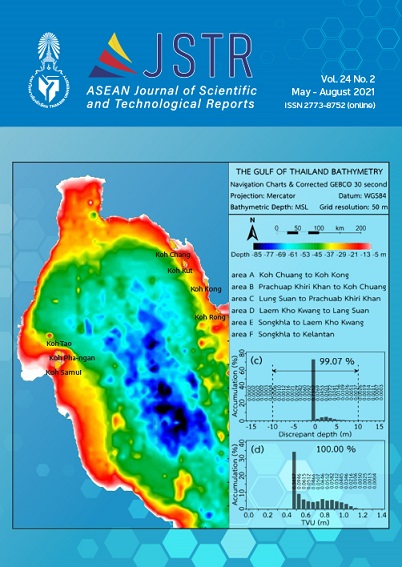Develop an Estimating Factor to Help Estimating Masonry Wall Area of Two Stories Houses
Main Article Content
Abstract
The most complicated and time-consuming step in estimating construction costs in determining the amount of material is a calculation of all areas for masonry works involving tedious processes. A simple estimating tool could assist estimators in estimating the amount of materials with reducing working time. The purpose of this research is to study the proportion of the masonry wall quantity to the building’s area and develop an estimating factor to estimate the masonry wall area of two-stories houses in 59 drawing construction for a case study. Using multiple linear regression analysis for independent variables that influence the dependent variable showed that the building area was an independent variable affecting the masonry wall area. The modeling to test, found that the masonry wall area less than the detailed estimation
as 0.50 - 6.78 %. Therefore, the model derived from this research, theref can apply for cost estimation and validation of the masonry wall area calculation of new project quickly.
Article Details

This work is licensed under a Creative Commons Attribution-NonCommercial-NoDerivatives 4.0 International License.
References
Thipparate, T., Chaisongkroh, N., & Kulprapa, N. (2017). Construction cost estimation of residential buildings by implementation of ANFIS, In The 22th National Convention on Civil Engineering (ICCE 2017).818-823. July 18–21, 2017, Nakhon Ratchasima: Suranaree University of Technology.
Nimmanpachrin, W., & Wantanakorn, D. (2016). Cost estimation of 2 storey residential buildings using montecarlo simulation technique, In The 1st Ratchathani University National Conference (RTUNC 2016). 331-342. July 29, 2016, Ubonratchathani: Ratchathani University.
Tuptimtong, A., Jaipunya, K., & Katavettavasak, S. (2017). The study of unit cost of electrical and communication systems, In The 22th National Convention on Civil Engineering (ICCE 2017). 716-721. July 18–21, 2017, Nakhon Ratchasima: Suranaree University of Technology.
Rujirayanyong, T. (2012). Estimate cost for apartment building using regression analysis. Rangsit University Journal of Engineering and Technology, 15, 33–39.
Supsri, P. (2002). Strategy for construction cost analysis (1st Ed.). Bangkok: S. Asia Press. [6] Chinanuwatwong, S. (2001). The construction cost estimation by using the ratio of reinforced concrete structure components. Kasetsart Engineering Journal, 44, 52–61.
Prapaporn, W., Chetchotisak, P., & Maneechotwong, J. (2018). The ratio of construction quantity analysis for reinforce concrete building, In The 23rd National Convention on Civil Engineering (NCCE23).1-5. July 18–21, 2018, Nakhon Nayok: Chulachomklo Royal Military Academy.
Mubarak, A., Tripoli, T., & Nurisra, N. (2018). The unit price implication of reinforcement usage in beam reinforced concrete construction. Aceh International Journal of Science and Technology, 5(1), 24–31.
Faisal, F., Zaini, S., & Selokumar, T. (2019). Evaluation of cost analyses for earthquake resistant reinforced concrete buildings based on Malaysian national annex to eurocode 8, In The AWAM International Conference on Civil Engineering 2019 (AICCE’19), 1485–1492. August 21-22, 2019, Penang: Malaysian.
Kanit, R., Gunduz, M., & Ozkan, O. (2007). Cost effect of earthquake region and soil type for office building in Turkey. Building and Environment, 42(10), 3616–2620.
Mubarak, M., Abdullah, A., Azmeri, A., & Hayati, Y. (2019). Cost estimation of structural components of a building by considering the seismic load on different regions. Advances in Civil Engineering, 2019, 7357913. https://doi.org/10.1155/2019/7357913.
Mishra, S., & Khan, M. A. (2018). Cost modeling of RC building designed in different seismic effects. International Research Journal of Engineering and Technology, 5(4), 4532–4537.
Ramli, M. Z., Adnan, A., Kadir, M. A. A., & Alel, M. N. A. (2017). Cost comparison for non-seismic (EC2) and seismic (EC8) design in different ductility class. International Journal of Civil Engineering and Geo- Environmental, 1(1), 38–42.
Sudha, J. L., & Venkateswarlu, D. (2016). Earthquake resistance design-impact on cost of reinforced concrete building. International Journal of Research Sciences and Advanced Engineering, 2(15), 75–86.
Yaman, H., & Tas, E. (2007). A building cost estimation model based on function elements. ITU A|Z, 4(1), 73–87.
Mahamid, I. (2011). Early cost estimating for road construction projects using multiple regression techiques. Australasian Journal of Construction Economics and Building, 11(4), 87–101.
Kitkanchanat, C. (2001). A study of major component’s ratio in housing construction for approved BOQ. Master’s Thesis. King Mongkut’s University of Technology Thonburi.
Tantiworrawit, W. (2012). Unit quantities of construction material in reinforced concrete government buildings. Master’s Thesis. Chiang Mai University.
Kanjina, P. (2014). Functional area based cost estimation model of residential buildings. Master’s Thesis. Chiang Mai University.
Jiradamkerng, W. (2006). Construction Specifications and Cost Estimation (1st Ed.). Pathumthani: Wankawee.
The Engineering Institute of Thailand under H.M. the King’s Patronage. (2005). Guidelines for measuring the quantity of building construction (1st Ed.). Bangkok: The Engineering Institute of Thailand under H.M. the King’s Patronage.
Wongrattana, C. (2017). Techniques Statistics for Research (1st Ed.). Bangkok: Amorn print.
Chianchana, C. (2017). Statistics for Research: Concepts and Applications (1st Ed.). Bangkok: Chulalongkorn University.
Chanabun, S. (2020). Multiple Linear Regression (Online). Retrieved November 3, 2021, from http://www.Google.com/search?Q=MultipleLinearRegression=chrome.0.0j69i57j0l5.9311j0j9&sourceid=chrome&ie=UTF-8.
The Comptroller General’s Department. (2012). The Rule of Cost Estimation in Building Construction (1st Ed.). Bangkok: The Comptroller General’s Department.


